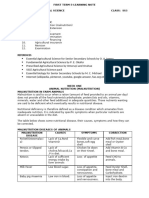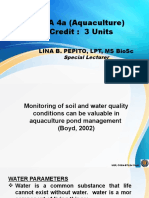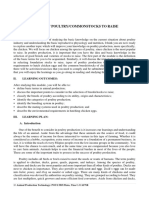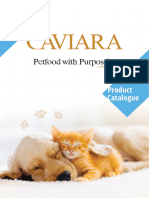Module 4. Animal Nutrition
Uploaded by
Kristine Hinayon CarpioModule 4. Animal Nutrition
Uploaded by
Kristine Hinayon CarpioModule 3 -
ANIMAL NUTRITION
I. OVERVIEW
This module will discuss about Animal Nutrition. Nutrition is important for a variety of reasons.
Animals need proper nutrition for growth and maintenance, and to provide energy for work and vital
functions. Without proper nutrition, animals can develop health problems which could result in
treatment costs or even fatality. This module will review the importance of basic nutrition concepts
and the function of essential nutrients that aids to support the life and productivity of an animal. It is
expected that at the end of this learning module, the students will appreciate the importance of animal
nutrition which is one of the utmost requisites in the study of animal production.
II. LEARNING OUTCOMES
After studying this module, you will be able to:
define terms used in animal nutrition.
identify the classification of feedstuffs;
identify the six basic classes of nutrients; and
describe the basic function of essential nutrients;
III. LEARNING PLAN
A. Introduction
The science of nutrition can be defined as the sum of different biochemical and physiologica l
processes which transform food/feed components into body elements that are required for sustaining
life, growth, health, and productivity. It involves ingestion, digestion, and absorption of the various
nutrients, their transport to all body cells, and the removal of unusable elements and waste products of
metabolism In farm animals such as livestock, pigs and poultry, nutrition is also important in
maintaining food (e.g. meat, milk, eggs) product quality, minimizing the cost of production, and loss
of undigested nutrients. Therefore, an understanding of basic nutrition concepts are very essential for
formulating rations and developing feeding practices for enhancing efficiency of food production
while protecting the environment and maintaining the nutritional value of animal-derived foods.
Animal nutrition is the science of nourishment of animals
Good nutrition is essential for all of the systems of an animal to function and work together
properly. Animals that do not receive the proper nutrition are more likely to develop health and
reproductive problems, and be less productive and marketable. Nutrition is important to have healthy
animals, and, in turn, healthy animals help ensure profitability in agricultural operations. A nutrient is
a food constitute that aids in the support of life. It may be a single element such as iron or copper, or
it may be a large, complex chemical compound such as starch or proteins, composed of many differe nt
units. A ration is the feed an animal receives over a 24-hour period. A ration with all the nutrients an
animal needs is a balanced ration. In animals with one stomach compartments like swine and poultry,
as well as calves and lambs up to several months of age usually need a concentrated ration. The ration
must be low in fiber and highly digestible, since these animals have a small stomach capacity and are
without the large numbers of microorganisms needed for bacterial digestion of fibrous feeds. These
animals, especially swine and poultry, grow and mature rapidly so the requirements of energy and
other nutrients are high in relation to feed consumption and capacity.
1 | Animal Production Technology 1: POULTRY PRODUCTION/Dato, Tina C./CAFNR
About 100 different nutrients are known to have value in livestock and poultry rations. Many are
individually required for normal body metabolism, growth and reproduction. The others are either not
essential or can be replaced by other nutrients.
Definition of Terms:
Nutrition
- is the study of the body’s need and mechanism for acquiring, digesting,
transporting and metabolizing nutrients.
- to “nourish”.
- “means all the processes whereby food & oxygen are presented to utilized by
living cells, and waste products are eliminated”.
Nutrient
- is any chemical elements or compound in the diet that supports normal
reproduction, growth, lactation, or maintenance of life processes. It may
include synthetically produced vitamins, chemically produced inorganic salts
or biogenically synthesized amino acids.
- is a substance that provides nourishment essential for growth and the
maintenance of life.
Food
- is an edible material that provides nutrients.
Feed
-
refers to food but is more commonly applied to animal food than to human
food.
Foodstuff or feedstuff
- is any material made into or used as food or fee, respectively.
- food of animals comprising any naturally occurring ingredient or material fed
to animals for the purpose of sustaining growth and development.
Diet
- is a mixture of feedstuffs used to supply nutrients to an animal.
Ration
- is a daily supply of food or feed.
- a fixed amount of feed for one animal, fed for a definite period, usually for a
24-hour period.
Digestion
- is the breakdown of feed particles into suitable products for absorption; may
include: mechanical, chemical action, and/or enzyme activity.
- a regulated selection of a feed ingredient or mixture of ingredients includ ing
water, which is consumed by animals on a prescribed schedule.
Health
- is the state of complete physical, mental and social wellbeing and not merely
the absence of disease or infirmity as defined by World Health Organization.
Ingredients
- any of the feed items that a mixture is made of.
Absorption
- is the movement of substances from the gastrointestinal tract (GIT) to the
circulatory (blood and lymph) system.
Metabolism
- is the combination of anabolic and catabolic reactions occurring in the body
with the liberation of energy.
2 | Animal Production Technology 1: POULTRY PRODUCTION/Dato, Tina C./CAFNR
Additives
- an ingredient or a combination of ingredients added to the basic feed mixture
for specific purposes like to increase feed ingestion or to alter metabolism.
Balanced ration
- the ration which provide an animal with the proper amount, proportion and
variety of all the required nutrients to keep the animal in its form to perform
best in respect of production and health.
Complete ration
- a single feed mixture, which has all of the dietary essentials except water for a
given class of livestock.
Bran
- the pericarp or seed coat of grain removed during processing.
Straw
- is the by-product of any cereal, millet or legume crop left over after harvesting,
threshing and removal of the grains or pulses.
Feed conversion ratio (FCR):
- the amount of feed in Kg or lb necessary to produce one Kg or one lb of weight
gain.
Calorie
- unit of measurement used for calculating the amount of energy produced by
various foods. It is the amount of heat needed to raise the temperature of I gram
of water by IOC (14.50C-15.50C).
Forage/Roughage
- poor quality feeds containing lesser amount of total digestible nutrients (TDN)
or more than 35 percent cell wall constituents and more than 18 percent of
crude fiber (CF).
Concentrate
- it contains little amount (less than 18 percent) of crude fibre and more than 60
percent total digestible nutrient.
Nutrients and their Basic Function:
Nutrients – is a substance that provides nourishment essential for growth and the maintenance of
life.
Functions:
1. provide energy
2. contribute to body structure
3. regulate chemical processes in the body
Feedstuffs Classification:
1. Concentrates – any feed low (under about 20%) in crude fiber and high (over 60%) TDN on an
air-dry basis. Opposite of roughage. Also, a concentrated source of one or more nutrients used to
enhance the nutritive adequacy of a supplement mix. For example, cereal grains are considered
primarily as energy sources, but also contribute a significant amount of protein supplements
generally feeds with more than 20% crude protein (CP).
Example:
Concentrates (energy sources)
Cereal grains: corn, sorghum, barley, rye, etc.
Grain-milling by products: corn bran, rice bran, corn gluten meal
3 | Animal Production Technology 1: POULTRY PRODUCTION/Dato, Tina C./CAFNR
Roots and tubers: cassava, potatoes, etc.
Food processing by-products: molasses citrus pulp, distiller’s by-products, brewer’s by-
products
Industrial by-products
Concentrates (protein supplements)
Oilseed meals: soybean, cottonseed, rapeseed, canola, linseed, peanut, safflower, and
sunflower meal
Grain legumes: beans, peas, lupins
Animal protein: meat meal, tankage, fishmeal, whey, and feather meal
Nitrogen sources for ruminants
Nonprotein nitrogen sources: urea, biuret, dried poultry waste
By-ass protein: corn glten meal
2. Roughage - any feed high (over about 20%) in crude fiber and low (under about 60%) in TDN,
on an air-dry basis. Hay, pasture, silage are examples of roughages. They are used mainly as feeds
for ruminants or non-ruminant herbivore.
Example:
Pasture
Grasses
Legumes
Green chop
Silage
Dry forages
Hay
Straw, stover, chaff
Agricultural by-products, e.q. corn cobs, hulls, bagasse
Feed Supplements and Additives
Mineral supplements: salt, limestone
Vitamin supplements
Synthetic amino acids
Drugs, e.q., antibiotic, ionophores
Preservatives, e.q. antioxidants, mold inhibitors
Buffers, Enzymes, Hormones, Flavors, Probiotics, Pellet binders
Nutrients required by animals:
Depending on age and species, animals require a source of nitrogen (N) in the form of essential
amino acids. Fats in the form of essential fatty acids, essential mineral elements, a source of energy
that may vary from primarily fat and protein for carnivorous animals to coarse fibrous plant tissue for
some herbivorous species, and some of the fat-and water-soluble vitamins.
The amount and proportion required are influenced by the type of gastrointestinal tract, the age of
the animal, its level of productivity, what type of productivity is in question (i,e., maintenance of body
tissues, work, growth, milk eggs, conceptus), the dietary components available, and other factors.
Because animals require more than 40 nutrients, meeting dietary requirements may be diffic ult,
depending on the availability of appropriate feedstuffs. Humans require the same nutrients as anima ls,
although the amounts of each nutrient needed for various body functions may differ.
4 | Animal Production Technology 1: POULTRY PRODUCTION/Dato, Tina C./CAFNR
Classes of Nutrients:
1. Carbohydrates
- the main source of energy in most livestock and poultry rations, make up 65 to 80 % of the
dry weight of nearly all grains and roughages. Energy supplied by carbohydrates is used
for:
1. maintenance
2. growth, which is formation of tissue such as meat and wool
3. reproduction, and
4. production of animal products such as eggs or milk
- energy for maintenance includes all that is used for voluntary and involuntary muscle
actions, such as walking, eating, blood circulation, and movement of food through the
digestive system.
- All carbohydrates contain the elements carbon, hydrogen, and oxygen.
Monosaccharides Disaccharides Polysaccharides
glucose sucrose Starch
fructose maltose Glycogen
galactose lactose Hemicellulose
Cellulose
lignin
2. Lipids (Fats or Ether Extract)
- are the most potent energy source in rations.
- fats and oils are also referred to as lipids.
- contain carbon, hydrogen and oxygen, although there is more C and H proportion to O than
with carbohydrates.
- contains 2.25 times more energy per unit than carbohydrates.
- function as source of energy (for fats/oils), and precursor for substance like prostagland ins,
structural components of cells (for fatty acids).
3. Proteins (Amino Acids)
- amino acids linked together to form a protein.
- contain C, H, O and N, and sometimes Fe, P or S, or both.
- proteins in feeds, on average, contain 16% N
- composed of various combinations of some 25 amino acids.
- Poultry, swine, and other non-ruminants need certain specific amino acids in their rations,
and there is an optimum level of each for maximum performance.
- an estimate of the total protein in a feed, however, is made by chemically measuring the
nitrogen content and dividing by 16% or multiplying by the factor 6.25. The value which
results from this calculation is called “crude” protein.
Essential Non-essential
arginine alanine
histidine aspartic acid
isoleucine citrulline
leucine cysteine
lysine glutamic acid
methionine glycine
phenylalanine hydroxyproline
5 | Animal Production Technology 1: POULTRY PRODUCTION/Dato, Tina C./CAFNR
threonine proline
tryptophan serine
valine tyrosine
- function: building blocks for growth, milk production, cell/tissue repair, metabolic
reactions, enzyme and hormone functions, etc.
4. Minerals
- are chemical elements other than C, H, O and N, and are inorganic.
classification:
1. Macrominerals or major minerals – relatively required in larger amounts in the body.
2. Microminerals or trace minerals – needed in very small amounts in the body.
Macrominerals: Trace/Microminerals:
calcium cobalt selenium
chlorine copper zinc
magnesium florine
phosphorus iodine
potassium iron
sodium manganese
sulfur molybdenum
- functions: Ca and P for bone growth
Na, K, Cl for osmotic relationship between plasma and RBC and acid-base
balance
trace minerals- essential parts of hormone, vitamins and other processes in the
body.
5. Vitamin
- organic substances required by animals in very small amounts for regulating various body
processes toward normal health, growth, production and reproduction.
- Fat-Soluble Vitamins – A, D, E, and K
- Water-Soluble Vitamins – ascorbic acid (C), B-complex (biotin, choline, cyanocobala mine
(B12 ), folic acid, niacin (B3 ), pantothenic acid, pyridoxine (B6), riboflavin (B2 ), and
thiamine (B1 ).
6. Water
- is vital to life. Life could not be sustained without water.
- the cheapest nutrients. Livestock normally consume three to four times as much water as
feed.
- contains hydrogen and oxygen, also called moisture.
- found in all feeds ranging from 10% in air-dry feeds to 80% or more in fresh green forages.
- animals consume several times more water than dry matter each day and will die from lack
of water more quickly than from lack of any other nutrient.
- basic body functions: it enters into most of the metabolic reactions, assist in transporting
other nutrients, helps maintain normal body temperature, and gives the body its physical
shape (as a major component in the cell)
Water Losses from the animal body:
- urine
6 | Animal Production Technology 1: POULTRY PRODUCTION/Dato, Tina C./CAFNR
- feces
- vaporization from the lungs and dissipation through the skin (insensible losses)
- sweat from the glands
Feeds can contain both high and low water percentages. Examples of feeds with high water contents
are young grass (± 15% DM) and cabbage (< 10% DM). Hay and concentrates arebfeeds with low
water contents (85-90% DM).
An animal obtains water from three sources: drinking water, water present in food and metabolic water.
The latter is formed during metabolism by oxidation of hydrogen (H) containing organic nutrients.
Water leaves the body with urine, feces, milk, and as vapor via the lungs (respiration) and the skin
(perspiration). There is no evidence that, under normal conditions, an excess of drinking water is
harmful. If water is offered ad lib, animals normally drink what they require.
The Three Basic Functions of Feed Nutrients:
1. as structural materials for building and maintaining the body structure.
- proteins, minerals, fats and water
2. as sources of energy for heat production, work, and /or fat deposition.
- carbohydrates, fats and proteins
3. as regulators of body processes/activities and as constituents of body-produced regulators.
- vitamins, minerals, amino acids and fatty acids
IV. SUMMARY
Nutrients are chemical elements or compounds that aid in the support of life. Animals must have
different groups of nutrients to grow and produce efficiently. Energy nutrients provide the energy
necessary for movement and production of body heat. Carbohydrates is the main source of energy in
most livestock and poultry rations and is used maintenance and growth. Proteins supply material to
build body tissues, hooves, horns, hair, and skin. Lipids or fats are the most potent energy source in
rations. Vitamins help to regulate many of the body’s functions. Minerals provide material for bones,
teeth, and tissues and help to regulate chemical activity in the body. Water dissolves and carries
nutrients, regulates temperature, and is necessary for chemical reactions in the body. Nutrients are
supplied by the grains and forages fed to the animal. Additional nutrients needed by the animal are
supplied by commercial feed mixes.
V. ACTIVITY/EXERCISE
Exercise # 3.
Animal Nutrition
Name Course/Year
Collect a sample/s of nutrient sources in poultry available in your home as many as you
can. Develop an exhibit of these samples showing the approximate percentage and description of
the nutrient/s that comes from each source. Submission will be at the portal for exercises in the
google classroom.
7 | Animal Production Technology 1: POULTRY PRODUCTION/Dato, Tina C./CAFNR
VI. REFERENCES:
Anna Dee Fails, et al. Anatomy and Physiology of Farm Animals. Eight Edition. Copyright 2018.
William O. Reece, et al. Dukes’ Physiology of Domestic Animals. Thirteenth Ed. Copyright 2015.
Frank Flanders, et al. Modern Livestock and Poultry Production. 8th Edition. Copyright, 2015.
L.I. Chiba, Animal Nutrition Handbook. 2nd Edition. Copyright, 2009
Udeybir Singh Chahal, et al. Handbook of General Animal Nutrition. 1st Edition. Copyright, 2008.
Pond, Church, Pond & Schoknecht. Basic Animal Nutrition and Feeding, by 5th edition.
Copyright, 2005,
D.V. Reddy, Principles of Animal Nutrition and Feed Technology. 2nd Edition. Copyright, 2001.
Online Sources:
https://www.academia.edu/12404360/Animal_Nutrition_Handbook
https://www.animal_nutrition_and_feeding_lecture_com.pdf
https://www.slideshare.com
https://www.nddb.coop/sites/default/files/Animal-Nutrition-booklet.pdf
https://www.nddb.coop/sites/default/files/Animal-Nutrition-booklet.pdf
https://open.oregonstate.education ›
https://www.academia.edu/31130715/_2008_Handbook_of_General_Animal_Nutrition_pdf
https://www.google.com.definition
https://www.med.libretext.org
Online Article:
Animal Nutrition Manual by Dr Atiq Ullah Khan Marwat
8 | Animal Production Technology 1: POULTRY PRODUCTION/Dato, Tina C./CAFNR
You might also like
- Final Animal Feeds and Nutrition 2nd Year VetNo ratings yetFinal Animal Feeds and Nutrition 2nd Year Vet263 pages
- 2-Lecture 1-Ransum Ruminansia-Balancing Rations - 8No ratings yet2-Lecture 1-Ransum Ruminansia-Balancing Rations - 880 pages
- Class 12: Nutrition-Definition-Ration-Balanced Ration-Desirable Characteristics of A RationNo ratings yetClass 12: Nutrition-Definition-Ration-Balanced Ration-Desirable Characteristics of A Ration32 pages
- Grade 11 Agriculture Science Week 3 Lesson 2No ratings yetGrade 11 Agriculture Science Week 3 Lesson 28 pages
- 1) History of Animal Nutrition, Importance of Nutrients and Nutritional Terms100% (1)1) History of Animal Nutrition, Importance of Nutrients and Nutritional Terms18 pages
- Chicken Nutrition A Guide For NutritionistsNo ratings yetChicken Nutrition A Guide For Nutritionists30 pages
- 635703232-FEEDS-AND-FEEDING-formulationNo ratings yet635703232-FEEDS-AND-FEEDING-formulation52 pages
- Dietary Supplements and Nutraceuticals: Nutritional Requirements and Health BenefitsFrom EverandDietary Supplements and Nutraceuticals: Nutritional Requirements and Health BenefitsNo ratings yet
- Animal-Based Diet for Beginners: Ancient Nutrition for Modern WellnessFrom EverandAnimal-Based Diet for Beginners: Ancient Nutrition for Modern WellnessNo ratings yet
- (Aquaculture) Monitoring of Soil and Water QualityNo ratings yet(Aquaculture) Monitoring of Soil and Water Quality33 pages
- (Fish Capture) Hand Instrument and Its VariationNo ratings yet(Fish Capture) Hand Instrument and Its Variation24 pages
- (Aquaculture) Water Quality Management in Aquaculture100% (1)(Aquaculture) Water Quality Management in Aquaculture24 pages
- Acceptability and Marketability of Bangus Ice Cream FINAL NA SIGUROO 1No ratings yetAcceptability and Marketability of Bangus Ice Cream FINAL NA SIGUROO 167 pages
- Elderhood: Jerry Mae Chiong Joliza Lancara Dianne Kay Fernandez Rhea Joy Golena0% (1)Elderhood: Jerry Mae Chiong Joliza Lancara Dianne Kay Fernandez Rhea Joy Golena50 pages
- Composition and Properties of Edible FlowersNo ratings yetComposition and Properties of Edible Flowers12 pages
- 5.1. Nutritional Requirements in ChildrenNo ratings yet5.1. Nutritional Requirements in Children63 pages
- Kissan Squash Uses Preservatives and High Amount of Sugar Which at This Covid-19 Situation Is Not Commendable As at This Time Everyone Needs Immunity ProductsNo ratings yetKissan Squash Uses Preservatives and High Amount of Sugar Which at This Covid-19 Situation Is Not Commendable As at This Time Everyone Needs Immunity Products2 pages
- 2-Lecture 1-Ransum Ruminansia-Balancing Rations - 82-Lecture 1-Ransum Ruminansia-Balancing Rations - 8
- Class 12: Nutrition-Definition-Ration-Balanced Ration-Desirable Characteristics of A RationClass 12: Nutrition-Definition-Ration-Balanced Ration-Desirable Characteristics of A Ration
- 1) History of Animal Nutrition, Importance of Nutrients and Nutritional Terms1) History of Animal Nutrition, Importance of Nutrients and Nutritional Terms
- Dietary Supplements and Nutraceuticals: Nutritional Requirements and Health BenefitsFrom EverandDietary Supplements and Nutraceuticals: Nutritional Requirements and Health Benefits
- Animal-Based Diet for Beginners: Ancient Nutrition for Modern WellnessFrom EverandAnimal-Based Diet for Beginners: Ancient Nutrition for Modern Wellness
- (Aquaculture) Monitoring of Soil and Water Quality(Aquaculture) Monitoring of Soil and Water Quality
- (Aquaculture) Water Quality Management in Aquaculture(Aquaculture) Water Quality Management in Aquaculture
- Acceptability and Marketability of Bangus Ice Cream FINAL NA SIGUROO 1Acceptability and Marketability of Bangus Ice Cream FINAL NA SIGUROO 1
- Elderhood: Jerry Mae Chiong Joliza Lancara Dianne Kay Fernandez Rhea Joy GolenaElderhood: Jerry Mae Chiong Joliza Lancara Dianne Kay Fernandez Rhea Joy Golena
- Kissan Squash Uses Preservatives and High Amount of Sugar Which at This Covid-19 Situation Is Not Commendable As at This Time Everyone Needs Immunity ProductsKissan Squash Uses Preservatives and High Amount of Sugar Which at This Covid-19 Situation Is Not Commendable As at This Time Everyone Needs Immunity Products































































































